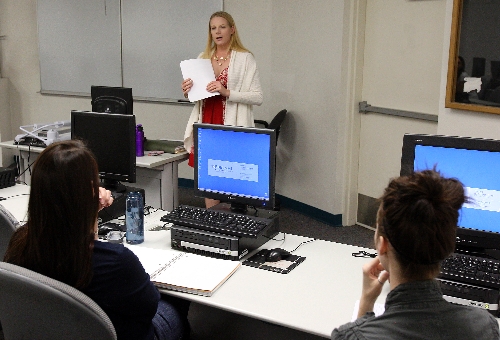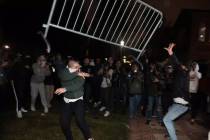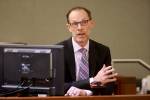Survey raises questions about women on the bench
Six of the seven district judges who received "do not retain" recommendations in this year's Judicial Performance Evaluation survey are women. For the past decade, the average retention score of women judges each year has been at least 7 points lower than the average for male judges.
Are these facts statistically significant?
Does it mean the lawyers who did the grading are biased against females?
Or does it mean that some women judges lack the requisite legal knowledge and temperament to be on the bench?
"That's a valid hypothesis," Dr. Rebecca Wood said of the latter. The political science professor at the University of Nevada, Las Vegas said, "I call it the affirmative action hypothesis. Maybe these women are scoring lower because they aren't good judges."
The argument for all of the above could also be made. After all, twice as many women judges earned high scores this year.
Judge Elissa Cadish, for instance, earned an 86 percent retention rating, among the highest of all judges. When asked whether she perceives gender bias in attorneys in her courtroom, Cadish said a handful of older male attorneys can be slightly condescending on a subconscious level.
"It isn't because they think women necessarily make bad judges," she said. "I think it's more of a generational thing. I don't take it personal."
There are no black and white answers to the question of possible bias, but according to Wood, who helped research such polls and presented her findings to a Nevada Supreme Court-appointed committee, it is critically important the answer is accurate.
This is particularly true if voters approve a ballot measure in November that would change how attorneys become judges. If approved, judges would be appointed by the governor from a list of lawyers drawn up by a nominating committee.
If so, surveys similar to what the Las Vegas Review-Journal has commissioned the past 18 years would be more than a voter guide -- they are expected to become the law.
"We have to sort this out before we go forward," Wood said. "We have to get this right."
Supreme Court justices have expressed support for a diverse judiciary, and clearly headway has been made. A decade ago, only six of the 27 Clark County district judges were women; today, there are 43 district judges in Clark County, and 19 of them are women. Female representation on the bench has doubled, from 22 percent to 44 percent. Of the current 25 general jurisdiction seats -- the District Court departments that deal with all civil and criminal cases other than the specialized matters reserved for Family Court -- women have a slight majority of 13.
About 26 percent of the nation's state judges are female -- 4,521 out of roughly 17,000, according to The American Bench. Thirty years ago, the number was about 300.
Of course, women didn't attend law school in large numbers until the 1970s, when federal civil rights laws banned the practice of many law schools of not admitting females, according to the Institute for the Advancement of the American Legal System
The Supreme Court justices have said they hope judges use judicial surveys as a learning tool, to take the score and the comments and use them to better prepare for trial. That might work for some but not for Judges Jessie Walsh or Kathy Hardcastle, who scored little better in 2010 than they did eight years earlier.
"I find it very puzzling," Walsh told the R-J in 2002. "Women judges tended to do particularly well in the last election. I have no idea why they graded low." Then, as now, Walsh, along with Family Court Judge Cheryl Moss, drew the lowest score, with only 36 percent of respondents giving the women a nod to retain.
Hardcastle, another low scorer at 46 percent, in 2002 suggested women judges scored poorly because they didn't have as much experience as their male peers.
Eight years later, however, Hardcastle continues to do poorly.
Attorneys rating the judges are allowed to offer anonymous comments explaining why they rate a given judge well or poorly. In Walsh's case, these comments tended to be harshly critical of her legal acumen and the perception she favors the plaintiff's attorney in civil cases.
"The queen of peremptory challenges," wrote one. A peremptory challenge is a request, which cannot be denied in Nevada if properly made, that the case be reassigned to some other judge. It's supposed to be made because an attorney, or his or her client, believes they won't get a fair shake in the original judge's courtroom, but a lawyer doesn't have to give any reason.
Walsh is challenged more than any other judge in Clark County.
"She simply does not have the intellect to be a judge," wrote another attorney. "She is in the pocket of the plaintiffs' attorneys and so obviously favors them."
Hardcastle's low marks, on the other hand, focused almost exclusively on her attitude. "Without a doubt the nastiest and (most) condescending demeanor of all of Clark County judges," wrote one lawyer.
From Wood's perspective, a spotlight needs to shine on the respondents.
"We need to determine their motivation," she said. "I wonder how many actually appeared before the judges they graded or based their comments on what they hear.
"How much is a real measure of ability and how much can be attributed to unfair bias? We don't really have good measures of judicial performance. That's why we resort to surveys like this."
Wood went to great pains to explain she was not critical of the firm that conducted the survey, Downey Research, and owner Nancy Downey.
"She did a great job gathering and analyzing the data," Wood said. "She did what she was asked to do. I don't fault Nancy or the R-J. They modeled it on (American Bar Association) guidelines like every other state did."
In 1985, the ABA, in an effort to develop a system to accurately measure judicial performance, designed a plan that has served as a template for judge evaluations.
Downey explained the genesis of the R-J survey: "The questions used for the current judicial survey were designed over 15 years ago in collaboration with Dr. Donald Carns of the UNLV sociology department, judges and attorneys, and R-J editors," Downey said.
"They have been updated only slightly over the years. I agree that this research study would benefit from a thorough review of the questions to address any concerns of bias. As my expertise is in the area of survey data collection and statistical analysis, I would welcome the involvement of a researcher more familiar with political science and legal issues such as Dr. Wood, if my client were to ask. I think judicial evaluations of this type provide a valuable service to voters because the results provide a perspective on judicial performance, which they might otherwise be unaware."
Wood has another hypothesis she calls the bitch factor.
"I'm guessing the bias is unconscious. It's not that the respondents are sexists; it's that we have a vision of what a judge should be."
Judges have traditionally been males, and society has been slow to change its expectations, Wood said.
"If a man is in control of the courtroom, he is considered assertive and authoritative, but a women exhibiting the exact same behaviors is seen as bitchy or overly aggressive," she said.
The comments about Judge Stefany Miley, another low scorer, attack her legal skills as well as her demeanor. Miley's reputation has also taken a hit because of conflicts in her personal life.
All four judges either offered a brusque "no comment" when contacted or did not return phone calls, but in 2004 Hardcastle had plenty to say on the subject of gender bias when 67 percent of respondents agreed she should be retained, 22 percentage points higher than 2010: "You're going to have a certain percentage of the bar who's going to be upset, and they treat the women judges differently. I don't notice it so much now as when I first began. There's a lack of formality and respect that they give to the (women) judges. I think they test the female judges more than they do the men. We see it as much or more from the female lawyers."
At the R-J's request, Downey recalculated separately the average retention scores given every judge by women, and by men. "When focusing on questions of retention only, overall, men and women did not tend to rate the judges differently," Downey found.
She added, though, that among 79 judges rated, there were eight exceptions in which genders differed on recommending particular judges, and the differences were statistically significant. In those cases, "male respondents tended to be easier on male judges and female respondents to be easier on female judges." Judges recommended more often by their own gender were Kathleen Delaney, Douglas Smith and Michael Villani of the District Court's civil/criminal division; Jennifer Elliot and Cynthia Giulani of the Family Court division, and justices of the peace Anthony Abbatangelo of Las Vegas, Stephen J. Dahl of North Las Vegas and Stephen George of Henderson. But an actual majority of each gender favored retaining each of the eight.
Female judges who did well in previous evaluations continued to do well in 2010 and those that fared poorly tended to continue in that vein.
In the study Wood wrote with Sylvia Lazos of the Boyd School of Law at UNLV and Mallory Waters, a graduate student at the school's political science department, the women note judicial performance surveys have been taken since the 1870s in pursuit of accountability.
The title of their study leaves no doubt how the women feel: "Sacrificing Diversity for 'Quality:' How Judicial Performance Evaluations are Failing Women and Minorities." In it they nonetheless said the R-J's surveys have been "one of the important sources of information to Clark County voters in the intervening years."
If voters pass a ballot question based on Senate Joint Resolution 2 and judges are appointed rather than elected, then the state will sponsor such surveys, by law, and that could be far more dangerous than a newspaper or state bar doing so because then, said Wood, they are sanctioned by the government and are "official."
SJR2 calls for creating a performance review commission and further states, "The review of each justice or judge must consist of a review of the record of the justice or judge and at least one interview of the justice or judge."
Although SJR2 does not mention a survey, the Article 6 Commission, a blue-ribbon panel appointed by the Supreme Court to review the state's entire justice system, is studying survey systems and expected to recommend the Supreme Court establish one under the authority implied by the proposed amendment.
More than 30 states have such polls, either officially or unofficially, regardless of how judges come to be, and Wood said they are all remarkably similar.
The UNLV study is groundbreaking in that few other states have systematically reviewed judicial performance surveys to see if they are inherently biased.
At the end of the day, Wood believes, some female judges scored poorly because they simply aren't bright or courteous enough to wear the robe. Others might have been victimized by a society that hasn't yet come to terms with females on the bench.
People stereotype whether they want to or not, said Wood
"I see it in my teaching evaluations. My students think I'm smart, but they also think I'm unapproachable and aloof, that I have no time for them," she said. "A male with the same amount of busyness is seen as important. That doesn't mean the students are biased. It's their world view. It's the same reason why male nurses don't score as high as traditional female nurses. It's perception."
Contact Doug McMurdo at dmcmurdo@review journal.com or at 702 224-5512.
SUNDAY
What lawyers say about running incumbents
How we evaluate judges
Whose scores dropped
Lawyers cut slack for new judges
MONDAY
Nine should go, lawyers say
TODAY
Do women judges get a fair test?
WEDNESDAY
All is calm in Henderson Justice Court
THURSDAY
It's about knowing the law
FRIDAY
Lawyers prefer appointing judges




























